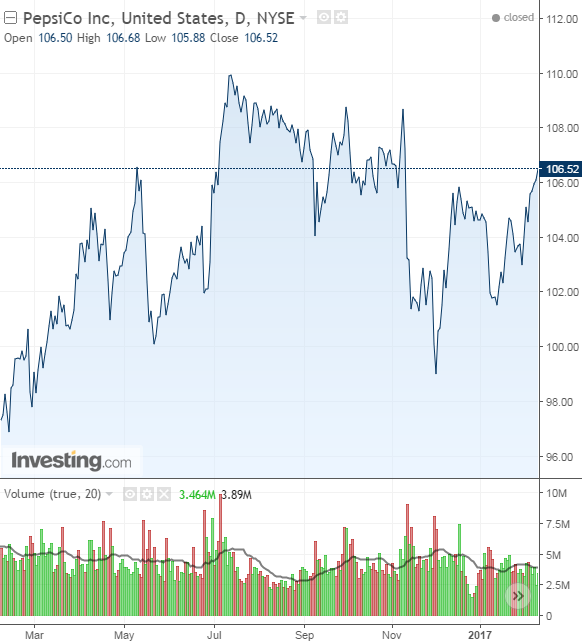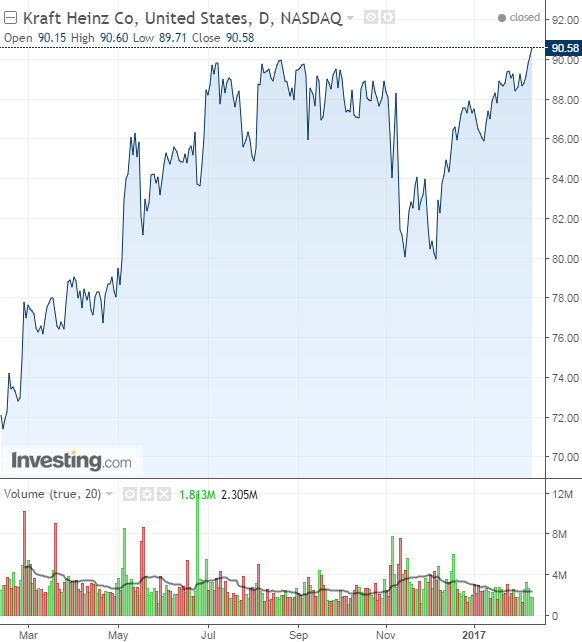by Clement Thibault
Kraft Heinz (NASDAQ:KHC) in its current form, was born in October of 2014, when Kraft Foods was acquired by the Heinz Holding Corporation. The merged company is one of the leading food companies in the world. Its rivals include Mondelez International (NASDAQ:MDLZ), General Mills (NYSE:GIS), and Kellogg (NYSE:K). The company is expected to report an EPS of $0.87 and revenue of $6.75 billion on Wednesday 15, 2017 after the closing bell.
PepsiCo (NYSE:PEP), an American multinational founded in 1898, specializes in snacks and beverages. The company operates in the same terrain as Coca-Cola (NYSE:KO), Dr. Pepper Snapple Group (NYSE:DPS) and Mondelez. It will also report on Wednesday 15, before the opening bell. It is expected to announce a Q4 EPS of $1.16 on $19.6 billion of revenue.
Both companies have built global food empires. Both produce an array of well-known products and own widely recognized household brands, many of which are consumed frequently, even daily.
Kraft Heinz owns such marquee brands as Kraft cheeses, Heinz ketchup, Jell-O, Kool-Aid and Oscar Meyer meats. PepsiCo's brand stable includes Pepsi and 7Up, Quaker, Gatorade, Cheetos, Lays and Doritos.
Both companies manufacture and sell consumer staples, products considered so essential that consumers are unlikely to stop buying them even during economic downturns, making them safe, if not sexy, companies to invest in. With both companies equally well established, are either, or both, still good investments?

PepsiCo: Something for everyone
PepsiCo has put in considerable effort over the the past few years to adapt its brand portfolio to more accurately reflect consumer demands. The company's latest acquisition, for an estimated $200 million, announced just before Thanksgiving 2016, was KeVita, a sparkling probiotic drink maker. KeVita is joining a family of PEP brands that has tilted toward health consciousness in recent years.
In fact, attention to healthful food options is built into the way PepsiCo currently divides its brand portfolio: "Good for You", "Better for You", and "Fun for You". The "Fun" part, as you might have guessed, includes most of the company's less healthy snacks, such as Lays and Pepsi itself. However, amid growing consumer awareness, government regulation of sugary drink sales and public health campaigns to reduce sugary drink consumption, PepsiCo's focus on healthier beverages and snacks speaks volumes about the company's initiative—and ability—to evolve and change as consumer trends fluctuate.
Geographically, PepsiCo's growth opportunities include much of the developing world. Right now, North America accounts for 58% of its revenue, but Latin America has been the star performer of 2016 thus far, showing organic growth of 10% in the first 9 months of the year. PepsiCo's growth in LatAm however, was offset by the divestiture of its Venezuela operations due to local government regulations.
Nevertheless, there's reason for optimism going forward. Over the same period, the company's Asia, Middle East and North Africa business showed organic growth of 5%. Developing world countries generally transition from phases of food scarceness to eras of prosperity, at which point leisure food consumption – PepsiCo's core business – becomes the norm.
With its promising presence in Africa, Asia and the Middle East, growing array of healthful snacks and drinks for fitness conscious North America and Europe and some of the most recognized snack brands globally, PepsiCo has the ability to cater to all nationalities and demographics for years to come.

Kraft Heinz: Cost saving and synergies
Kraft Heinz has taken a different trajectory since the merger three years ago. Rather than focus on portfolio growth, the market in which it operates, and customer demands, the company has opted to target cost saving and synergies. During November 2015, the company announced it would close seven US-based factories, eliminating 2600 jobs, in an effort to move production away from its less effective plants. The strategy is ongoing; this past November, KHC closed its Lehigh Valley, PA plant.
These efforts, as well as the merger itself, stem from the relative weakness of the company in North America. The United States accounts for 70% of the Kraft Heinz's revenue, making it by far the company's most important market. Unfortunately, organic revenue in the US dropped by 1.2% over the first 9 months of 2016, a steeper decline than the 1% decline the company suffered across the board during the same period.
Acquisition as a way of bolstering weakness is also difficult for Kraft Heinz given the amount of debt the company currently carries. Its long term debt now stands at $30 billion, more than four times its TTM EBITDA.
For the time being, Kraft Heinz's focus remains on improving its bottom line, cutting back on inefficiencies and removing some of the debt load from its balance sheet, all before growth through strategic acquisition or internal innovative development can continue. That could mean a bumpy short-term outlook for the company, even if profitability improves. KHC's lack of focus on broader industry trends is a concern going forward.
Conclusion
The main problem we see for Kraft Heinz is that it is obviously a company that's in transition. Unfortunately, at $90.58 a share as of yesterday's close, with a P/E ratio of almost 35—quite a bit higher than the sector average of 26—it carries a hefty premium. Some of this might be explained by the defensive nature of the stock and the company, since food will continue to be bought no matter what other cutbacks consumers feel compelled to initiate.
We suspect a part of the premium is also related to Warren Buffett's Berkshire Hathaway (NYSE:BRKa), which has a 27% stake in the company. Berkshire Hathaway and 3G Capital bought Heinz in 2013 and were integral in initiating the Kraft buyout the following year.
Investors often like to stand on the shoulders of market giants, and there's no one more venerated for his investing acumen than the Oracle of Omaha. Kraft Heinz's current valuation could also reflect the market's belief in Mr. Buffet's ability to accomplish a turnaround at Kraft Heinz.
From our perspective, even at $106.52 per share as of last night's close, PepsiCo's valuation is more attractive. Its P/E ratio of 23 is lower than the market's 26 average, and as discussed, PepsiCo is free to focus on growing and adapting the business to the ever-changing market, something it has already proven itself adept at. As well, PepsiCo is more diversified both in its product offering and in the geographical distribution of its revenue sources.
PepsiCo's dividend has a 2.77% yield and has grown, and been paid, for the past 44 years. Kraft Heinz's dividend currently yields 3.23% and it's been paid regularly since the merged company's inception three years ago. Of note: Heinz paid reliable dividends for decades, before the merger.
Our intention with this post wasn't to actually compare two similar companies, head-to-head. Nevertheless, if forced to choose, we prefer PepsiCo's potential growth and current valuation over Kraft Heinz's, even with the Buffet Factor thrown in.
